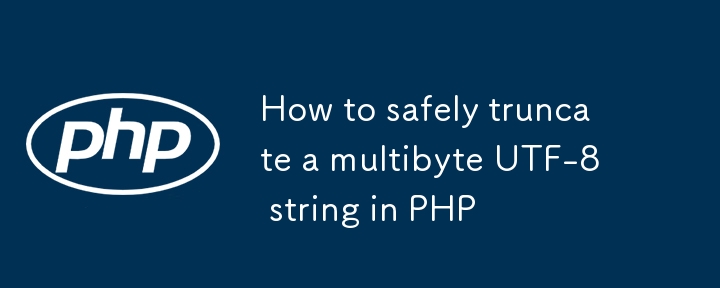To safely shorten a UTF-8 string in PHP with multibyte characters, use mbstring functions like mb_substr() with explicit UTF-8 encoding instead of substr(), avoid falling back unless input is ASCII-only, handle byte-length truncation carefully by backtracking to valid UTF-8 boundaries using functions like safe_truncate_bytes(), and for visual integrity, consider grapheme_substr() from the Intl extension for handling grapheme clusters such as emojis with modifiers.

When you need to shorten a UTF-8 string in PHP, especially one that might contain multibyte characters like emojis or characters from non-Latin alphabets (e.g., Chinese, Japanese, Cyrillic), doing it the wrong way can result in broken characters or invalid strings. The key is to use functions that understand multibyte encodings rather than assuming each character is a single byte.

Use mbstring Functions Instead of Default String Functions
PHP’s default string manipulation functions like substr() assume each character is exactly one byte, which isn’t true for many UTF-8 characters. For example, an emoji like ? takes up 4 bytes in UTF-8. Using substr() on such a string could cut it off mid-byte-sequence and leave you with garbage.
Instead, always use the mb_ prefixed functions from the mbstring extension, particularly mb_substr():

mb_substr($text, 0, $length, 'UTF-8');
Make sure to specify 'UTF-8' as the encoding parameter — don't rely on defaults, especially if your code might run in different environments.
- Always check if
mbstringis enabled usingfunction_exists('mb_substr')- Avoid falling back to
substr()unless you're certain the input is ASCII-only
Be Careful with Byte Length vs Character Length
Sometimes, you might want to truncate based on byte size instead of character count — for example, when storing data in a field with a byte limit. In that case, you have to be extra cautious not to split multibyte sequences.

One safe approach is to start truncating at a byte position slightly below your limit and then backtrack until you find a valid UTF-8 start byte:
function safe_truncate_bytes($str, $maxBytes) {
if (strlen($str) <= $maxBytes) return $str;
$head = substr($str, 0, $maxBytes);
$lastValidPos = mb_strlen($head, 'UTF-8');
while ($lastValidPos > 0) {
$candidate = mb_substr($str, 0, $lastValidPos, 'UTF-8');
if (mb_check_encoding($candidate, 'UTF-8')) {
return $candidate;
}
$lastValidPos--;
}
return '';
}This ensures that even if you cut off part of a multibyte character, you roll back to the last complete character.
Handle Edge Cases Like Emojis and Grapheme Clusters
Even with mb_substr(), there are cases where what appears to be one character is actually made up of multiple Unicode code points — for example, skin tone modifiers or flag emojis. These aren't handled correctly by mbstring.
If you really need to preserve visual character integrity (like cutting by visible graphemes), consider using the Intl extension and grapheme_substr():
if (function_exists('grapheme_substr')) {
$shortened = grapheme_substr($text, 0, $charLimit);
}This is more accurate for user-facing display truncation but comes with heavier dependencies.
So yes, safely truncating a UTF-8 string in PHP involves more than just slicing it. It means respecting multibyte boundaries, being aware of encoding, and sometimes thinking about how characters are visually composed. Once you get these basics right, it's not too bad — just make sure you test with some real-world examples like emojis, accented letters, and non-Latin scripts.
The above is the detailed content of How to safely truncate a multibyte UTF-8 string in PHP. For more information, please follow other related articles on the PHP Chinese website!

Hot AI Tools

Undress AI Tool
Undress images for free

Undresser.AI Undress
AI-powered app for creating realistic nude photos

AI Clothes Remover
Online AI tool for removing clothes from photos.

Clothoff.io
AI clothes remover

Video Face Swap
Swap faces in any video effortlessly with our completely free AI face swap tool!

Hot Article

Hot Tools

Notepad++7.3.1
Easy-to-use and free code editor

SublimeText3 Chinese version
Chinese version, very easy to use

Zend Studio 13.0.1
Powerful PHP integrated development environment

Dreamweaver CS6
Visual web development tools

SublimeText3 Mac version
God-level code editing software (SublimeText3)

Hot Topics
 How do I implement authentication and authorization in PHP?
Jun 20, 2025 am 01:03 AM
How do I implement authentication and authorization in PHP?
Jun 20, 2025 am 01:03 AM
TosecurelyhandleauthenticationandauthorizationinPHP,followthesesteps:1.Alwayshashpasswordswithpassword_hash()andverifyusingpassword_verify(),usepreparedstatementstopreventSQLinjection,andstoreuserdatain$_SESSIONafterlogin.2.Implementrole-basedaccessc
 How can you handle file uploads securely in PHP?
Jun 19, 2025 am 01:05 AM
How can you handle file uploads securely in PHP?
Jun 19, 2025 am 01:05 AM
To safely handle file uploads in PHP, the core is to verify file types, rename files, and restrict permissions. 1. Use finfo_file() to check the real MIME type, and only specific types such as image/jpeg are allowed; 2. Use uniqid() to generate random file names and store them in non-Web root directory; 3. Limit file size through php.ini and HTML forms, and set directory permissions to 0755; 4. Use ClamAV to scan malware to enhance security. These steps effectively prevent security vulnerabilities and ensure that the file upload process is safe and reliable.
 What are the differences between == (loose comparison) and === (strict comparison) in PHP?
Jun 19, 2025 am 01:07 AM
What are the differences between == (loose comparison) and === (strict comparison) in PHP?
Jun 19, 2025 am 01:07 AM
In PHP, the main difference between == and == is the strictness of type checking. ==Type conversion will be performed before comparison, for example, 5=="5" returns true, and ===Request that the value and type are the same before true will be returned, for example, 5==="5" returns false. In usage scenarios, === is more secure and should be used first, and == is only used when type conversion is required.
 How do I perform arithmetic operations in PHP ( , -, *, /, %)?
Jun 19, 2025 pm 05:13 PM
How do I perform arithmetic operations in PHP ( , -, *, /, %)?
Jun 19, 2025 pm 05:13 PM
The methods of using basic mathematical operations in PHP are as follows: 1. Addition signs support integers and floating-point numbers, and can also be used for variables. String numbers will be automatically converted but not recommended to dependencies; 2. Subtraction signs use - signs, variables are the same, and type conversion is also applicable; 3. Multiplication signs use * signs, which are suitable for numbers and similar strings; 4. Division uses / signs, which need to avoid dividing by zero, and note that the result may be floating-point numbers; 5. Taking the modulus signs can be used to judge odd and even numbers, and when processing negative numbers, the remainder signs are consistent with the dividend. The key to using these operators correctly is to ensure that the data types are clear and the boundary situation is handled well.
 How can you interact with NoSQL databases (e.g., MongoDB, Redis) from PHP?
Jun 19, 2025 am 01:07 AM
How can you interact with NoSQL databases (e.g., MongoDB, Redis) from PHP?
Jun 19, 2025 am 01:07 AM
Yes, PHP can interact with NoSQL databases like MongoDB and Redis through specific extensions or libraries. First, use the MongoDBPHP driver (installed through PECL or Composer) to create client instances and operate databases and collections, supporting insertion, query, aggregation and other operations; second, use the Predis library or phpredis extension to connect to Redis, perform key-value settings and acquisitions, and recommend phpredis for high-performance scenarios, while Predis is convenient for rapid deployment; both are suitable for production environments and are well-documented.
 How do I stay up-to-date with the latest PHP developments and best practices?
Jun 23, 2025 am 12:56 AM
How do I stay up-to-date with the latest PHP developments and best practices?
Jun 23, 2025 am 12:56 AM
TostaycurrentwithPHPdevelopmentsandbestpractices,followkeynewssourceslikePHP.netandPHPWeekly,engagewithcommunitiesonforumsandconferences,keeptoolingupdatedandgraduallyadoptnewfeatures,andreadorcontributetoopensourceprojects.First,followreliablesource
 What is PHP, and why is it used for web development?
Jun 23, 2025 am 12:55 AM
What is PHP, and why is it used for web development?
Jun 23, 2025 am 12:55 AM
PHPbecamepopularforwebdevelopmentduetoitseaseoflearning,seamlessintegrationwithHTML,widespreadhostingsupport,andalargeecosystemincludingframeworkslikeLaravelandCMSplatformslikeWordPress.Itexcelsinhandlingformsubmissions,managingusersessions,interacti
 How to set PHP time zone?
Jun 25, 2025 am 01:00 AM
How to set PHP time zone?
Jun 25, 2025 am 01:00 AM
TosettherighttimezoneinPHP,usedate_default_timezone_set()functionatthestartofyourscriptwithavalididentifiersuchas'America/New_York'.1.Usedate_default_timezone_set()beforeanydate/timefunctions.2.Alternatively,configurethephp.inifilebysettingdate.timez






